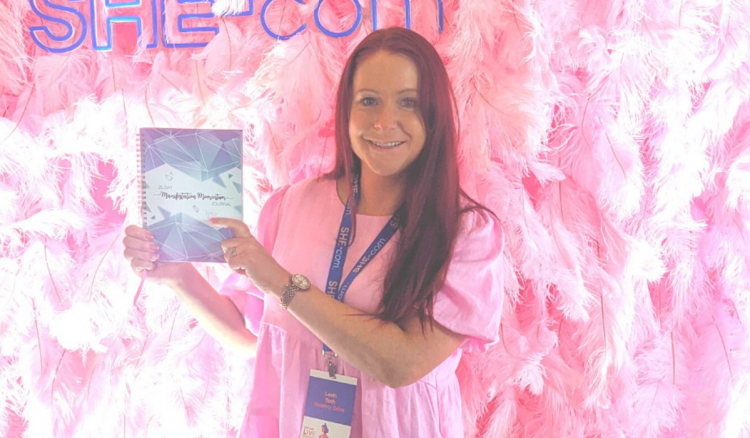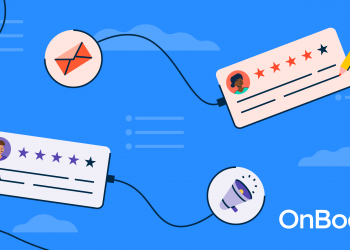“Spiritual stationery. I think that kind of sums it up nicely.”
That’s how Leah Toth describes her fledgling company, Destiny Drive, which was born from her love of journaling.
Toth started Destiny Drive in 2020 during Australia’s lockdowns. “There was something about that first lockdown,” she says. “I gained weight eating poorly, drinking too much, feeling very unmotivated.”
During the second lockdown, however, that all turned around. “Something about that second lockdown just really put a fire in me to want to lose weight and be healthier and have more positive habits.”
She began a weight loss tracker as well as a money manifestation tracker. Every night at dinner, she and her husband would each name one thing they were thankful for. Toth also knew she wanted to build a side business, but the kind of business she should start had her stumped.
One day, she decided to write in her journal about opening a side business, and all the pieces came together.
And then I had that horrible moment where I thought I had a great idea, but then I realized the idea already exists.
But Toth, a student of foundr’s course, Start & Scale, found her answer in the program.
“I think [the course] gave the example of going to the shops and having a look at how many different loaves of bread there are. Just because other people make bread doesn’t mean you can’t make bread as well. You just make it a bit different.”
She didn’t have to stress about being first-to-market with a brand-new product—she just had to find a gap no one else had recognized. Toth bought every manifestation journal she could find and flipped through their pages.
“The best thing was, I didn’t like any of them,” she says. “They didn’t meet what I thought was good in a manifestation journal.”
She had found her gap. Now, she simply had to fill it.
The Manifestation Journal
Toth launched her business with the Destiny Drive Manifestation Journal, a 26-day journal that focuses on self-care and personal development.
“For those who have maybe heard of The 75 Hard, which is all about two exercises a day and pushing yourself to the limits, doing a strict diet, all those sorts of hard things, I like to think that my journal is like The 26 Soft. It’s a challenge, but it’s not as intense,” she says.
The journal includes self-assessment tools, which Toth calls a backward bucket list. Customers use the journal to assess their achievements thus far. It’s an opportunity to feel gratitude for where they are and identify where they can grow.
Next is a page filled with flower pots that represent life categories—love and career, for example. Here, they can draw flowers that represent various parts of their lives. Users then spend the next 26 days cultivating positive habits that help them reach their goals. At the end of the 26 days, they are encouraged to look back on those flowers to see how far they’ve come.
“It’s just about embedding positive habits and positive behaviors every day, expressing gratitude, and simple things like making your bed every day and drinking water, like really easy things to do,” Toth says. “And if you do them all consistently for a while, then you build up quite a lot of positive habits, and then you’re on track toward your goals.”
While the journal encourages users to set goals, Toth also says she’s an advocate for skipping a day.
“It’s one of those things where you don’t have to do it perfectly. If you miss a day here or there, you still get a lot of benefit out of it,” she says.
Building a Better Journal
To get the project off the ground, Toth got out her journal and took a hard look at how she used it. She noticed patterns in her journaling and began grouping them into different sections.
Using Canva, she created a prototype she could use to help her communicate her vision—layout, page number, tabs for different sections—to designers.
She found her designer in the Start & Scale group—a woman who was just as into manifesting as she was.
“She even had her own podcast about manifesting,” Toth says. “So I was like, ‘Yep, you’re the person for me.’”
She started with 250 journals printed locally and set a goal of selling out in six months, which she did. Then, she ordered 500 from a manufacturer in China and resolved to sell those in six months.
She hit that goal, too.
With organic traffic on the rise and an entire tool kit of well-honed marketing tactics, Toth is on track to triple her original goal within the year.
Creating a Community Around Manifestation
One of the biggest surprises for Toth has been the sheer number of return customers. It’s been slightly more than 12 months since she launched the journal, and she already has customers who have bought 7 or 8 journals. Return customers are a solid affirmation of Toth’s vision. They may also be proof of one piece of feedback she hears often: People wish the journal was longer.
On the other hand, Toth’s diverse and well-mapped marketing strategy certainly doesn’t hurt. Toth’s marketing runs across platforms, from organic to paid ads, and she is constantly experimenting with new channels and new content.
She also understands the importance of building community across channels.
“I really tried hard to get that first 1,000. I wasn’t just sharing on my personal page saying, ‘Oh, can you please follow me.’ I was personally messaging every single person in my friend list. And I felt like a bit of a psycho saying, ‘Oh, hi. I know we haven’t spoken, but I’d really appreciate it if you could follow me. I’m really trying to build up my following.’”
Her Facebook group is one of the key elements of her product, however. Through it, Toth has built a strong community. Customers who buy her journal (either the paper or digital version) have exclusive access. They can join challenges, talk with other group members, and engage with Toth.
First-time customers keep coming back to the group for the sense of community, turning them into loyal Destiny Drive brand ambassadors.
The Facebook group also allows Toth to collect feedback she can use to improve her existing products and generate ideas for new ones.
“I found that the Facebook group is amazing for that. Especially when I’m doing these group challenges. On the 26th day, I just say, ‘How’s it gone? What have you liked about it?’ And that’s just amazing to take those little snippets, to capture everything that they’ve said.”
She also uses the Facebook group to conduct a yearly group challenge, where everyone starts the journal on the same day. There are giveaways and prizes throughout the year on Facebook and Instagram.
She’s a big believer in offering her customers exclusive perks to keep them feeling like they’re a part of something. For example, at the end of the 26 days, journal writers get to open their crystal surprise pouch, something she was inspired to do after taking the Start & Scale course.
“You can’t open this till the end of the 26 days, and the crystals will be different for everybody. So you don’t know what you’re going to get.”
Toth has a few other tactics in her back pocket, as well:
Email: Before the launch of the journal—and her website—Toth focused on her email list. “I think the email is definitely really important because anything could happen to your Instagram or your Facebook, but you own your email list.”
Pop-ups: At first, Toth says, she felt a little cringy about using pop-ups on her website. But she soon realized they were just part of the game. “I still now try to get a lot of new emails on the email list by having a pop-up that says if you put your email address in, you get a discount code. And you also get this free manifesting tool, which is like a blank check that they can print out and write down how much money they want to manifest.”
Influencer marketing: Toth admits she has only dabbled in influencer marketing and didn’t notice much of a lift for her efforts. “I’m still always on the lookout for microinfluencers that are often pretty happy just to share something in exchange just for product only,” she says.
Text marketing: Toth is very interested in expanding into text marketing. “I know that that’s really good now, and that’s taking off because the chance of opening a text message is a lot higher than opening an email these days. But I just haven’t quite bitten that bullet yet, where I know that I should, and I’ll get more people on board that way.”
Subscription boxes: Toth treats subscription boxes as a marketing activity, keeping her price as low as possible—even below wholesale. She is always on the lookout for new subscription box businesses, keeping an eye on their growth, and engaging them on Instagram. She tries to gauge just the right moment to reach out to them when they’re still small enough and eager enough for products but not so small that they wouldn’t order enough journals.
The Art of the Upsell
Toth’s final marketing tool is the upsell. For example, she’s taken that feedback about the journal being longer and started working on a 12-month planner. Once again, she’s gone out and bought every planner she could find.
“I don’t want to just put another planner on the market,” she says.
“I want to do something similar to what I’ve done with this journal: find the gap and find what’s missing and find what I would actually use myself.”
Toth wants to build something that complements the journal rather than copies it.
It’s a strategy she’s already using to upsell to customers. She currently offers journaling pens that contain different crystals. Customers can choose from three different crystals and add the pens to their purchases. In the past, Toth has offered exclusive products, such as affirmation cards in product bundles.
“That’s a bit of a marketing tactic to get that average order value up,” Toth says. “And I just know for myself as a consumer, I’ve fallen for that plenty of times. I’ve seen bundles, and I just really want that one thing. And I just end up buying the whole bundle instead.”
Toth is also toying with the idea of an affirmation cuff.
“What if you spent $100, then you get the free affirmation cuff to try and really boost that average order value to try and make that much higher?”
While Toth is mulling other products, she is very careful about what she offers. In fact, she has pared down bundles and other products on the site to focus back on the journal.
“I’m thinking I’m sort of muddying the water a little bit by having a little bit too much to choose from at the moment.”
Read more: How Samantha Brett Built Naked Sundays into Australia’s #1 SPF Skincare Brand
Advice for Fellow Beginners
Though Toth’s business is just beginning, she’s already sharing some big takeaways with other fledgling entrepreneurs. Her biggest piece of advice: Starting a business might not be as hard or overwhelming as you think.
“You could get a bit carried away by all these bros that say, ‘Oh, I make $100k a month,’ and things like that,” she says. “It doesn’t need to be like that. It can be easy. It can be fun. It can feel like a hobby. It doesn’t have to feel like work. So as long as it’s something that you like doing, then you’re going to love doing it.”
Click here to get the same strategies Toth used to start and scale Destiny Drive.
Source by foundr.com











